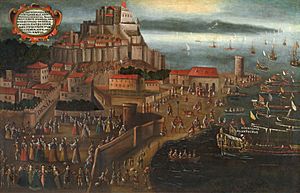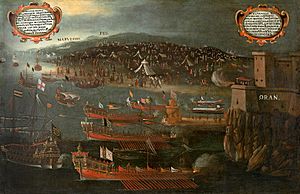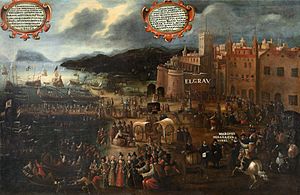Expulsion of the Moriscos facts for kids

The Expulsion of the Moriscos was ordered by King Philip III of Spain on April 9, 1609. The Moriscos were people in Spain whose families had been Muslims. They had been forced to become Christians.
Spain was fighting wars in other parts of the world. The Spanish also felt threatened by attacks from the Turks along their coast. There had also been two revolts by Moriscos in Spain. Because of these reasons, the king decided to expel the Moriscos. This was a way to deal with problems inside the large Spanish Empire.
Between 1492 and 1610, about 3,000,000 Muslims left or were forced out of Spain. From 1609 to 1614, the Spanish government systematically expelled Moriscos. This happened through many orders that affected different parts of Spain. About 275,000 to 300,000 Moriscos were expelled in the early 1600s. Some experts believe there were about 500,000 Moriscos in total. About half of them managed to avoid being expelled or returned to Iberia (Spain and Portugal).
The expulsion was very strong in the eastern Kingdom of Valencia. Here, Moriscos made up most of the farmers. There was a lot of tension between them and the Christian, Catalan-speaking middle class. This region carried out the expulsion most strictly. It led to a big economic collapse and many areas became empty. A terrible disease, the bubonic plague, made things even worse a few years later. The Kingdom of Aragon had the next largest group of Moriscos after Valencia. Aragon also suffered greatly from the economic problems.
Most of those who were permanently expelled settled in the Barbary Coast (Maghreb), Italian Peninsula, Sicily or Constantinople. About 50,000 Moriscos eventually returned to different parts of Spain. Those who stayed or came back slowly blended into the main culture. The last major legal action against Moriscos for secretly practicing Islam happened in Granada in 1727. Most people found guilty received light punishments. By the end of the 1700s, it was thought that Islam and Morisco identity had disappeared in Spain.
Contents
Why the Expulsion Happened
There was a lot of suspicion and tension between Moriscos and other Christians. Moriscos were called New Christians, and other Christians were called Old Christians. This tension was high in some parts of Spain but almost nonexistent in others. Some Moriscos were powerful and even held church positions. But others, especially in Valencia and Aragon, were cheap workers for the local nobles. Where there was conflict, Old Christians suspected Moriscos were not truly Christian. Muslims who remained Muslim were known as Mudéjar. Many Moriscos, however, were truly Christian. In Granada, many Moriscos even became Christian martyrs. They were killed by Muslims for refusing to stop being Christian. Much of the dislike between Old and New Christians was based on their family background, not just religion.
Several revolts broke out. The most famous was the revolt from 1568 to 1573. This was against a rule by Phillip II. It banned Arabic language and names. It also required Moriscos to send their children to be taught by priests. After the revolt was put down, Philip ordered the Moriscos from Granada to be spread out to other areas. Philip hoped this would break up the Morisco community. He wanted them to blend in with the rest of the Christian population. This might have worked a little for Granada's Moriscos. But it did not work in Valencia or Aragon. In these areas, Islam was still widely practiced. Tensions were much higher there than in other parts of Spain.
Around the same time, Spain lost more than half of its lands in the Low Countries to the Protestant Dutch Republic. The rulers already saw Spain as the protector of Catholic Christianity. This defeat made them think more extremely. They wanted to strike back to regain Spain's honor. Some Protestant countries insulted Spain, saying it was corrupted by Muslims and secret Muslims. Some nobles might have taken these insults personally.
The situation got worse in the early 1600s. An economic downturn hit in 1604. The amount of gold and treasure from Spain's American lands decreased. This made life harder for everyone. It led to more tension between Moriscos and Old Christians over valuable jobs.
How Different Regions Felt About Moriscos
The exact number of Moriscos in Spain at the time of the expulsion is not known. Most estimates are based on how many were expelled. Numbers between 300,000 and 400,000 are often mentioned. However, newer studies estimate there were between 500,000 and one million Moriscos in Spain in the early 1600s. The total population of Spain was about 8.5 million.
A large number of Moriscos lived in the former Crown of Aragon. It is thought they made up one-fifth of the population there. In the Kingdom of Valencia specifically, they were one-third of the total population. The rich people and those in cities were mostly Christians. Moriscos lived in the countryside and poor areas outside the cities.
Moriscos in Castile
In the Crown of Castile, which included the Guadalquivir valley in what is now Andalusia, things were quite different. The number of Moriscos was generally lower. More importantly, most of them were former Mudejar (Muslims) Christians. They were well-integrated into society. They had given up many of their unique cultural ways. Unlike in Valencia, their Old Christian neighbors did not dislike them. Many neighbors even protected them from the king's attempts to expel them. For example, in Plasencia, officials sent to deport Moriscos were jailed when they arrived. In Avila, local Moriscos held positions in the church and government to avoid expulsion.
However, another group of Moriscos lived alongside these Mudejar Moriscos. These were many Granada Moriscos who had been moved after the uprising in 1571. They were viewed with more suspicion in their new communities. Because local people felt sympathy for Moriscos, Castile and Andalusia only made weak efforts to find and expel them. The expulsion was slower and less thorough than in Aragon and Valencia. A significant number of Moriscos, perhaps even a majority, either avoided expulsion or returned in the years after.
Moriscos in Aragon
In the Kingdom of Valencia, where most Moriscos in the Crown of Aragón lived, the situation was very different from Castile. Valencian Moriscos were mostly landless farmers. They lived separately from Christian populations. Economic and social competition caused a lot of anger towards them. This was especially true from the middle classes of artisans. This anger had boiled over before in 1520. In the Revolt of the Brotherhoods, artisan guilds in Valencia rebelled against both the nobles and the Muslim mudéjar farmers. The rebellion was defeated in 1523. But the rebels killed many and forced the mass baptism and conversion of the remaining Muslim population. In 1525, King Charles upheld these forced conversions. This created the Moriscos of Valencia. The Valencian Moriscos suffered the most during the expulsion. This was due to the long-standing hostility from their Christian neighbors.
Almost everyone in Spain agreed that Islam was a threat that should be stopped. However, it was not clear how this applied to the Moriscos, who were officially Christian. Some church leaders, like Fray Luis de Aliaga, a royal advisor, thought Moriscos should be given time to blend in and become full Christians. The Catholic Church in Rome also mildly supported this idea. The strongest defenders of the Moriscos were the nobles of Valencia and Aragon. They benefited most from the poor and cheap workers that the Moriscos provided.
Many other important people and groups opposed this view. Church leaders against Aliaga included Jaime Bleda. He was a very important member of the Spanish Inquisition in Valencia. Bleda made several early suggestions to King Philip III to banish or end the Morisco problem. He even suggested extreme measures to wipe out the group. At first, these requests did not succeed. In 1596, the Duke of Lerma, King Philip III's main financial officer, accused the Moriscos of helping the Muslim Barbary pirates. This charge had followed them for years. Still, while many people believed this, others thought this threat had passed. The Council of Aragon opposed any harsh actions. They wrote that even if Moriscos wanted to betray Spain, they could not. This was because "they possess no arms, nor supplies, nor fortified positions, nor a base for the Turkish fleet." Nothing came of it at the time, but the Duke of Lerma continued to dislike the Moriscos.
The Order and the Expulsion Process

The Duke of Lerma finally convinced King Philip III. He was helped by the Archbishop of Valencia, Juan de Ribera. The archbishop believed all Moriscos were heretics and traitors. The archbishop added an idea to make the plan more appealing to the king. The king could take all the money and property of the Morisco population. This would give a huge one-time boost to the royal treasury. Ribera also encouraged the king to make the Moriscos work without pay in galleys (ships), mines, and abroad. He said the king could do this "without any worries." But this idea was rejected.
On April 9, 1609, the order to expel the Moriscos was signed. The government knew that sending so many people away would be difficult. They decided to start with Valencia, where most Moriscos lived. Preparations were made in strict secrecy. Starting in September, army units called tercio battalions arrived from Italy. They took positions in the main ports of Valencia: Alfaques, Dénia, and Alicante. On September 22, the viceroy (a royal governor) ordered the decree to be announced. The nobles of Valencia met with the government to protest the expulsion. Losing their workers would ruin their farm incomes. The government offered them some of the confiscated property and land of the Moriscos. But this did not come close to making up for their losses. Moriscos were allowed to take anything they could carry. But their homes and land would go to their masters. Burning or destroying their homes before the transfer was forbidden, with the penalty of death.
Some exceptions were made. Six families out of every 100 could stay. They would maintain the buildings in towns that were mostly Morisco. Very few took this offer. They thought they would likely be exiled later anyway. Also, children less than four years old did not have to leave. This was later changed to children under 16. Archbishop Ribera strongly opposed this part. He argued that at least the children should be separated from their parents. He wanted them to be forced to work and become Christian "for the good of their souls."
On September 30, the first exiles were taken to the ports. As a final insult, they had to pay for their own trip. The Moriscos were transported to North Africa. Sometimes, they were attacked as invaders by the people in the countries they arrived in. Other times, small revolts broke out on the ships. This caused some exiles to be killed in fights with the crew. This created fear among the Moriscos still in Valencia. On October 20, there was a rebellion against the expulsion. About 6,000 rebels held the remote valley of Ayora and Muela de Cortes. Five days later, a new rebellion broke out on the southern coast. About 15,000 rebels held the Valley of Lugar.
The rebels were defeated by November. In just three months, 116,000 Moriscos had been sent to North Africa from Valencia. Early 1610 saw the expulsion of Moriscos from Aragon (the specific area of Aragon, not all the lands of the old Crown of Aragon). 41,952 were sent to North Africa via Alfaques. 13,470 were sent over the Pyrenees Mountains to France. The French, annoyed, sent most of them to the port of Agde. Those who traveled by land were charged both a transit fee and the sea fare. In September, the Moriscos of Catalonia were exiled. Andalusia also exiled about 32,000 Moriscos.
Expelling the Moriscos of Castile, Extremadura, and Andalusia (all part of the Crown of Castile then) was the hardest task. They were spread out after the rebellion was put down in 1571, not gathered in one place. Because of this, Moriscos were first given the option to leave voluntarily. They could take their most valuable belongings and anything else they could sell. So, in Castile, the expulsion lasted three years, from 1611 to 1614.
How Many Moriscos Were Expelled?
It is very hard to know how successful the expulsion was in removing all Moriscos from Spain. This topic has been looked at again by experts recently. Even estimates of the number of Moriscos in Spain before the expulsion vary. Some numbers, based on expulsion records, are around 300,000. More recent estimates go up to one million.
Also, traditional Spanish history and early studies often said the expulsion was well-managed. They claimed it successfully sent most Moriscos (around 270,000) out of the country quickly. As a result, early estimates of Moriscos who stayed in Spain after the expulsion were as low as 15,000.
However, many recent studies have questioned the idea that the expulsion completely removed the Morisco population. Modern studies have found that the expulsion had very different levels of success. This was especially true in the two main Spanish crowns of Castile and Aragon. One of the first English-language re-examinations was by Trevor J. Dadson in 2007. Dadson estimated that as many as 40% of Moriscos (around 200,000) never left the country. He also found that up to 70,000 of those expelled managed to return. A big part of his work focuses on Villarubia de los Ojos in southern Castile. The Moriscos of this town were targeted by three expulsions. They managed to avoid them or return to their hometown. Their non-Morisco neighbors protected and hid them. Dadson gives many examples of similar events across Spain. Moriscos were protected and supported by non-Moriscos. They returned in large numbers from North Africa, Portugal, or France to their original towns.
A similar study on the expulsion in Andalusia found it was not very effective. Its harshness was greatly reduced by resistance from local authorities and people. It also showed a constant flow of returnees from North Africa. This created a problem for the local Inquisition. They did not know how to deal with those who had been forced to convert to Islam while in Muslim lands because of the Royal Decree. When Felipe IV became king, he ordered officials to stop trying to punish returnees. In September 1628, the Council of the Supreme Inquisition told inquisitors in Seville not to prosecute expelled Moriscos "unless they cause significant trouble."
A study published in 2012 showed that thousands of Moriscos remained in the province of Granada alone. They survived both the first expulsion to other parts of Spain in 1571 and the final expulsion of 1604. These Moriscos managed to avoid the royal orders in various ways. They then hid their true family background. More surprisingly, by the 1600s and 1700s, many in this group became very wealthy. They controlled the silk trade and held about a hundred public jobs. Most of these families, however, completely blended in over generations. This happened even though they often married within their own group. A small group of active secret Muslims was prosecuted by the Inquisition in 1727. They received relatively light sentences. These convicted people kept their identity alive until the late 1700s.
Also, many Moriscos from the Catalan Low Ebro were officially not expelled. They stayed in their villages and towns. Some others who were expelled also returned. This was because they were very well integrated into Catalan Christian society. This was unlike those in Aragon, Valencia, and even the Moriscos of the Catalan Low Segre.
Many Moriscos settled in the Ottoman Empire around 1609-1620s, especially in Galata.
Impact of the Expulsion
The Council of Castile reviewed the expulsion in 1619. They concluded it had no economic impact on the country. This was mostly true for Castile. Some experts have found no economic problems in areas where Moriscos were important. However, in the Kingdom of Valencia, fields were abandoned. There was a gap in parts of the economy that native Christians could not fill. The Kingdom of Valencia lost 33% of its people. Some areas in the north of the current Alicante province lost almost everyone. Buildings and systems fell apart. The Christian nobles and landlords fell into arrears (debt). Needing money, many Valencian nobles increased rents for their Christian tenants. They hoped to get close to their old income. The higher rents stopped new tenants from coming to replace them. As a result, farming output in Valencia dropped greatly.
The expulsion was a huge blow not just to the economies of Aragon and Valencia. It also hurt the power of their nobles. The former Crown of Aragon had been less powerful than the richer Crown of Castile for some time. But with this, their standing dropped even further. Among the eastern kingdoms themselves, the Catalan nobles now became more important. Their incomes were much less affected. Unlike their neighbors to the south and west, they never had many Moriscos. So, the expulsion helped shift power away from its traditional centers in Valencia to the Principality of Catalonia within the Crown of Aragon.
Modern Efforts
Spain has a policy to make it easier for descendants of Jews who were expelled from Spain to get Spanish citizenship. Because of this, Muslims have asked for a similar policy for the descendants of the Moriscos. In 2006, this idea got support from the parliament of Andalusia. However, it has not gained wider support.
See also
 In Spanish: Expulsión de los moriscos para niños
In Spanish: Expulsión de los moriscos para niños
- Persecution of Muslims
- Treaty of Granada (1491)
- Alhambra Decree
- Edict of Expulsion
- Edict of Fontainebleau
- 1731 Expulsion of Protestants from Salzburg
- Republic of Salé
Images for kids




